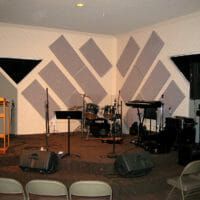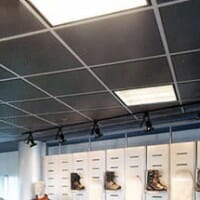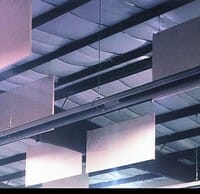Nightclub Soundproofing – Keep the Bass Big, but Keep it Inside
No one goes to a nightclub when they’re looking for a quiet night of relaxation. We go to nightclubs to dance and sweat out the week’s worries with great people and booming basslines. Nights at the club are incredibly cathartic, and a great venue provides a place where we can watch our favorite DJs and bands move the crowd with the music we love.
In an environment where sound is this important, paying close attention to the impact the environment has on sound waves is crucial. Nightclub soundproofing and acoustical treatment can make the difference between attracting a great crowd with your superior sound and having your music shut down due to noise complaints.
Why nightclub soundproofing is important
As much as we may enjoy being engulfed by big beats, too much noise can present practical problems. From missed orders to hearing loss, there are some very real downsides to operating in loud environments. Soundproofing a bar can cut down on them tremendously.
Let’s look at some of the benefits associated with reducing noise levels in overly noisy nightclubs.
Fewer miscommunications
First, nightclubs can be a tough place to have any type of conversation due to the competing sounds coming from the PA and the other patrons. When it comes to ordering your drinks, that translates into potential order errors. You can always talk louder, but that only exacerbates the noise situation and may even cause concertgoers to lose their voices. Operating at more reasonable audio levels not only makes the music sound better, but it allows patrons to spend quality time with their friends and encourages more efficient service.
Protection for employees and patrons
Nightclubs are regularly subjected to audio levels that greatly exceed those that OSHA has determined to be damaging to hearing. While earplugs are a good way to help curb the noise and protect your hearing, they can also lead to miscommunications and order errors. Chronic exposure to loud noises has also been shown to increase stress levels and make it harder to concentrate. These aren’t ideal for anyone, let alone those whose jobs serve to take orders and make guests feel comfortable.
Nightclub soundproofing efforts are an important part of protecting the ears and mental health of the people who work there, as well as those who show up to let loose.
Maintaining relationships with local residents and businesses
A great set of music drifting through the open door of a nightclub can entice passers by to join the party, but it can also cause headaches for the people who live and work nearby. Nightclub soundproofing is a great olive branch that you can extend to the members of your community. So, while your guests are enjoying the quality sounds they paid to hear, your neighbors can enjoy a little peace and quiet.
Nightclub soundproofing options
When it comes to soundproofing any space, we have a number of options that do a great job of cutting sound transmission. When it comes to soundproofing a nightclub, those options have got to look great as well. Choosing the right materials for nightclub soundproofing and acoustical treatments will not only help make your room sound better, but they’ll make it look better to boot.
Acoustical treatments
The first step in soundproofing nightclubs is to lower the volume of the soundwaves you are generating inside. The hard, smooth surfaces that lend themselves so well to both the nightclub’s aesthetic and the ability of staff to clean can wreak havoc when it comes to soundwaves.
When waves impact these types of surfaces, they bounce back into the room, creating echo and reverberation, which is a buildup of soundwaves with no place to go. Adding softer, more porous materials will allow soundwaves to get absorbed rather than bouncing back into the room. They can create a great juxtaposition with the hard surfaces common in the nightclub design aesthetic.
Fabric wrapped acoustical panels
When learning how to soundproof a nightclub, one of the most popular and effective solutions you’ll come across is the fabric wrapped acoustical panel. When placed at levels where sound waves tend to impact walls, acoustical panels can absorb enough sound energy to reduce echo and reverberation and create a much more pleasant sound that allows guests to hear their friends more clearly.
Fabric wrapped acoustical panels are available in dozens of great prints and colors and can be custom printed with any image you like, meaning your acoustical treatments will pull double duty by serving as artwork that cultivates the kind of atmosphere that sets your club above the other establishments in the area. They look great and are popular with patrons and proprietors alike. You can’t go wrong.
Ceiling clouds
Acoustical panels aren’t limited to wall spaces. They can also be mounted to or suspended from the ceiling, creating visually stunning overhead spaces and capturing sound waves that originate above and below them. Many nightclubs have unfinished ceilings, so the pipes and HVAC components that run overhead can contribute to noise pollution in the space.
Suspending ceiling clouds below those overhead noise makers means many of the sounds they create get absorbed before they reach the people in the room, and the voices and melodies created below don’t get reflected back into the room and make it harder for everyone to hear. If you’re looking to upgrade your nightclub soundproofing plan with something that delivers unmatched visual appeal, ceiling clouds are a great idea.
Bass traps
While acoustical panels do a good job of absorbing many of the frequencies produced by live musicians and the crowds that dance along, low frequency sound waves present additional challenges. In order to soak up these waves, you’ll need additions to your acoustic treatment arsenal such as a low frequency absorbing trap.
Bass traps are specifically designed to damp low frequency soundwaves, and are generally placed in the corners of rooms, and along wall joints where bass waves tend to build up. Since vibration caused by low frequency waves cause a good deal of the sound you are trying to reduce, adding a few to your nightclub soundproofing plan is a great idea.
Soundproofing
Nightclub soundproofing looks a little different than adding acoustical treatments. Acoustically treating the room will make the sound levels more tolerable, but soundproofing reduces sound transmission from the inside of the club to the surrounding neighborhood or adjacent units within your building.
Add mass and density to the walls
If your building is made of brick or concrete, you’ve already got a leg up. Materials like brick and concrete are already loaded with mass and density, meaning you’ll have an easier time keeping the music where it belongs. If your exterior walls are less dense, or if you share the building with other tenants, things get trickier.
You can still create soundproof walls for nightclubs if you’re working with wood and sheetrock, but you’ve got a little more work to do. Mass loaded vinyl is a great option here. This dense vinyl can be rolled out onto your existing walls and easily add mass and density. You can also add a second layer of drywall with a layer of green glue between the sheets. Not only will it add more mass, but the green glue serves to dampen the soundwaves, meaning the vibrations won’t pass so readily to the next surface.
Build a room within a room
When we aim to keep soundwaves from making their way from one space to another, decoupling is one of the most effective methods of making that happen. In a nutshell, decoupling is the act of separating one thing from another. By decoupling the wall surface from the structure behind it, soundwaves are unable to pass from one surface to the next.
While this may be the best way to soundproof a bar, it can come at a high cost if you have to contract out the labor.
Add insulation
This may seem like a no-brainer, but adding insulation to the cavities between surfaces is a great option when soundproofing your nightclub. Sealing open gaps allows sound waves to be absorbed as they pass from one surface to the next, meaning less sound ultimately makes it to the other side. Not all insulation is created equal, though, so make sure you are using a product that adequately meets your needs.
Windows
Large windows at the front of the club may be great for promoting the party inside, but they can be large contributors to noise outside of the club. If you’ve got windows showcasing your club, it’s important to make sure they aren’t leaking too much sound. You will want to determine how much noise is being leaked and what is acceptable. From here, you may want to look into installing soundproof glass windows.
The first thing to do is assess the age of the windows. If they are quite old, a new set could vastly improve their ability to insulate against both sound and the elements. Choosing windows with multiple panes and a gas filled gap between them will make a world of difference. Not only will they keep the neighbors happy, but you’ll get a nice little surprise when your heating and cooling bills arrive.
If your club is located in a historic building with old, beautiful windows, you may not want to change the look by installing modern windows. If that’s the case, you can achieve a good deal of sound and thermal insulation with climate seal window inserts. They can be built to suit, meaning no window is too big or small to be treated with window inserts. Hanging some sound absorbing curtains in front of them will help absorb additional sounds and may create a little mystery about what’s going on inside, driving curious clients through your doors.
Plan and execute
Soundproofing a nightclub doesn’t have to be painful. Identify your problem areas, consult with professionals, and utilize quality materials. You can start small or go all in. The choice is yours. Nightclub soundproofing is a great investment in protecting the people who make your business successful, as well as those who live and work nearby. Once you learn how to soundproof a bar and make the decision to do so, the benefits will stack up quickly.






